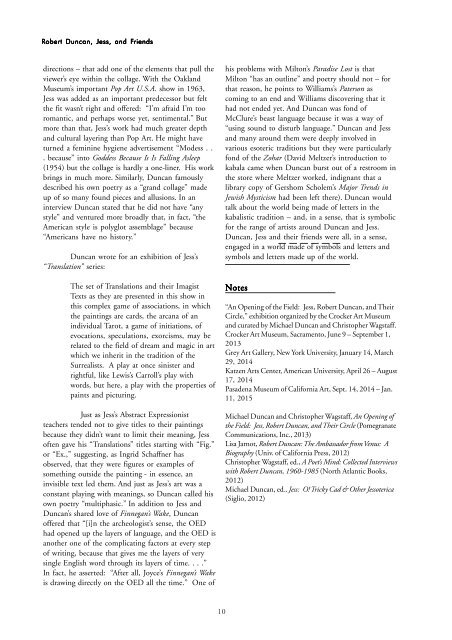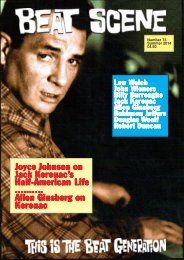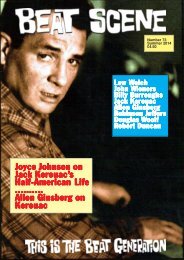You also want an ePaper? Increase the reach of your titles
YUMPU automatically turns print PDFs into web optimized ePapers that Google loves.
Robert Duncan, Jess, and Friends<br />
directions – that add one of the elements that pull the<br />
viewer’s eye within the collage. With the Oakland<br />
Museum’s important Pop Art U.S.A. show in 1963,<br />
Jess was added as an important predecessor but felt<br />
the fit wasn’t right and offered: “I’m afraid I’m too<br />
romantic, and perhaps worse yet, sentimental.” But<br />
more than that, Jess’s work had much greater depth<br />
and cultural layering than Pop Art. He might have<br />
turned a feminine hygiene advertisement “Modess . .<br />
. because” into Goddess Because Is Is Falling Asleep<br />
(1954) but the collage is hardly a one-liner. His work<br />
brings in much more. Similarly, Duncan famously<br />
described his own poetry as a “grand collage” made<br />
up of so many found pieces and allusions. In an<br />
interview Duncan stated that he did not have “any<br />
style” and ventured more broadly that, in fact, “the<br />
American style is polyglot assemblage” because<br />
“Americans have no history.”<br />
Duncan wrote for an exhibition of Jess’s<br />
“Translation” series:<br />
The set of Translations and their Imagist<br />
Texts as they are presented in this show in<br />
this complex game of associations, in which<br />
the paintings are cards, the arcana of an<br />
individual Tarot, a game of initiations, of<br />
evocations, speculations, exorcisms, may be<br />
related to the field of dream and magic in art<br />
which we inherit in the tradition of the<br />
Surrealists. A play at once sinister and<br />
rightful, like Lewis’s Carroll’s play with<br />
words, but here, a play with the properties of<br />
paints and picturing.<br />
Just as Jess’s Abstract Expressionist<br />
teachers tended not to give titles to their paintings<br />
because they didn’t want to limit their meaning, Jess<br />
often gave his “Translations” titles starting with “Fig.”<br />
or “Ex.,” suggesting, as Ingrid Schaffner has<br />
observed, that they were figures or examples of<br />
something outside the painting - in essence, an<br />
invisible text led them. And just as Jess’s art was a<br />
constant playing with meanings, so Duncan called his<br />
own poetry “multiphasic.” In addition to Jess and<br />
Duncan’s shared love of Finnegan’s Wake, Duncan<br />
offered that “[i]n the archeologist’s sense, the OED<br />
had opened up the layers of language, and the OED is<br />
another one of the complicating factors at every step<br />
of writing, because that gives me the layers of very<br />
single English word through its layers of time. . . .”<br />
In fact, he asserted: “After all, Joyce’s Finnegan’s Wake<br />
is drawing directly on the OED all the time.” One of<br />
his problems with Milton’s Paradise Lost is that<br />
Milton “has an outline” and poetry should not – for<br />
that reason, he points to Williams’s Paterson as<br />
coming to an end and Williams discovering that it<br />
had not ended yet. And Duncan was fond of<br />
McClure’s beast language because it was a way of<br />
“using sound to disturb language.” Duncan and Jess<br />
and many around them were deeply involved in<br />
various esoteric traditions but they were particularly<br />
fond of the Zohar (David Meltzer’s introduction to<br />
kabala came when Duncan burst out of a restroom in<br />
the store where Meltzer worked, indignant that a<br />
library copy of Gershom Scholem’s Major Trends in<br />
Jewish Mysticism had been left there). Duncan would<br />
talk about the world being made of letters in the<br />
kabalistic tradition – and, in a sense, that is symbolic<br />
for the range of artists around Duncan and Jess.<br />
Duncan, Jess and their friends were all, in a sense,<br />
engaged in a world made of symbols and letters and<br />
symbols and letters made up of the world.<br />
Notes<br />
“An Opening of the Field: Jess, Robert Duncan, and Their<br />
Circle,” exhibition organized by the Crocker Art Museum<br />
and curated by Michael Duncan and Christopher Wagstaff.<br />
Crocker Art Museum, Sacramento, June 9 – September 1,<br />
2013<br />
Grey Art Gallery, New York University, January 14, March<br />
29, 2014<br />
Katzen Arts Center, American University, April 26 – August<br />
17, 2014<br />
Pasadena Museum of California Art, Sept. 14, 2014 – Jan.<br />
11, 2015<br />
Michael Duncan and Christopher Wagstaff, An Opening of<br />
the Field: Jess, Robert Duncan, and Their Circle (Pomegranate<br />
Communications, Inc., 2013)<br />
Lisa Jarnot, Robert Duncan: The Ambassador from Venus: A<br />
Biography (Univ. of California Press, 2012)<br />
Christopher Wagstaff, ed., A Poet’s Mind: Collected Interviews<br />
with Robert Duncan, 1960-1985 (North Atlantic Books,<br />
2012)<br />
Michael Duncan, ed., Jess: O! Tricky Cad & Other Jessoterica<br />
(Siglio, 2012)<br />
10





